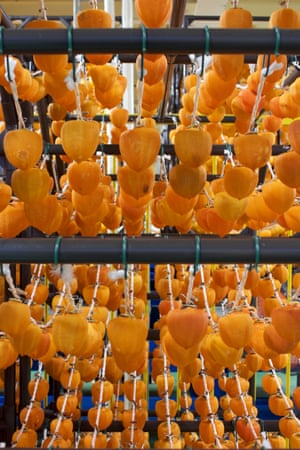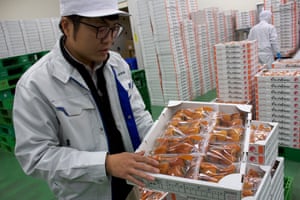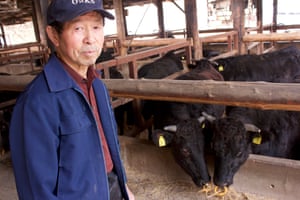Knives are wielded in silence as chunks of meat are sliced up and placed in containers, the reputation of an entire region resting on every step of the process being completed without a hitch.
Staff at the Fukushima Agricultural Technology Centre are dissecting samples of beef neck; on other days it could be batches of cucumbers and peaches, or fish from the nearby Pacific Ocean.
In an adjacent room, the containers are placed inside machines to be tested for the radionuclides caesium-134 and caesium-137. Every sample shows radiation levels well within national safety standards.
These daily rituals are central to a testing regime that officials in Fukushima prefecture say proves that the region’s produce is safe to eat, nine years after the nearby Fukushima Daiichi nuclear power plant suffered meltdowns in three of its reactors, all but destroying the local brand.
“The image of Fukushima produce took a hit after the March 11 disaster, and some of that reputational damage is still there,” says Hideaki Suzuki, an official in the prefectural government’s agriculture, forestry and fisheries department. “Some people have a certain fixed image, so it is up to us to provide them with accurate information.”
As Japan prepares to mark the anniversary of the triple disaster – in which a magnitude-9 earthquake caused a tsunami that killed more than 18,000 people and triggered the nuclear plant crisis – producers are preparing to demonstrate their recovery on the biggest stage in world sport: the Olympics.
Organisers have dismissed speculation that the coronavirus outbreak would force them to cancel the Games, but there is lingering concern about food safety.
An organising committee official confirmed this week that produce from areas affected by the 2011 earthquake and tsunami, including Fukushima, would be served at the athletes’ village, but that specific menus and catering plans had yet to be finalised.
The agricultural centre tests as many as 200 samples of different foods a day, according to Kenji Kusano, the director general of the agricultural safety promotion department at the Fukushima prefectural government. “Experts from the International Atomic Energy Agency come every year to check our work,” Kusano tells the Guardian during a tour of the facility. “We always receive an A grade.”
The Fukushima prefectural government says that, post-disaster, its food safety standards are among the most stringent in the world. The government-set upper limit for radioactive caesium in ordinary foodstuffs, such as meat and vegetables, is 100 becquerels per kilogram, compared with 1,250Bq/kg in the European Union and 1,200Bq/kg in the US.

Between April 2018 and March 2019, the prefecture tested more than 9m samples of local unpolished rice. Not a single sample exceeded the safety standard. Thousands of samples of fruit and vegetables, seafood and meat yielded similar results.
But those reassurances have failed to convince sports authorities in South Korea, who have voiced concerns that food served at the athletes’ village could contain “contaminated” Fukushima produce.
The Korean Sport and Olympic Committee has said it will take its own non-perishable food to Tokyo 2020 and carry out radiation checks on meat and vegetables that can only be sourced locally due to stringent quarantine regulations.
Alternatively, when the committee finalises its plan next month, it could ask Japan’s government to relax quarantine rules on fresh South Korean produce during the Games.
“For this Olympic Games, food is our team’s main focus, so athletes can be provided with safe meals and not have any radiation worries,” Shin Dong-keun, a member of South Korea’s parliamentary sports committee, told Reuters in December.
That level of caution, coinciding with a rise in political tensions between the two countries, irritates cattle farmers near Fukushima Daiichi who, having been told to destroy their animals after the disaster, are now selling meat again.
“No meat goes to market without being tested,” says Fumiya Koga, a prefectural government agriculture official. “If we didn’t do that, and meat was found to be above the limit, it would do serious damage to Fukushima’s reputation. In the nine years since the disaster, not one beef sample has exceeded the safety standard.”
Other agricultural sectors have mounted a similar recovery. Shipments of anpokaki (dried persimmons) – a popular, if pricey, winter delicacy – were banned for two years after the disaster, recalls Takeshi Haga, the director of anpokaki promotion at the Fukushima Mirai agricultural cooperative. “Radiation fears really affected us at first,” he says.

While local farmers struggled to counter harmful rumours swirling around Fukushima produce, Haga and his colleagues quickly set up their own testing regime, imposing an upper limit of 50Bq/kg of fruit, half the maximum permitted by the government.
“We test every single persimmon, even now,” says Haga. Each one is packed and given a quality control sticker showing its radiation reading, before being sold in north-east Japan, and the Tokyo and Osaka areas.
“Some local sellers ask us if it’s really still necessary to have stickers on each fruit nine years on from the disaster,” he adds. “But we think it’s best to keep reassuring consumers that our fruit is 100% safe, even if it means creating extra work.”
As they prepare to promote their region’s food to visiting athletes and spectators, officials are encouraged by the shrinking list of countries that continue to ban or limit imports of Fukushima produce.

Initially, more than 50 countries and regions refused to import items from Fukushima, but the number has since fallen to about 20, with Singapore recently joining countries such as the US and Australia in lifting or easing import bans. China, however, has kept its ban in place, while South Korea continues to prohibit seafood imports.
Noboru Tamogami, a 77-year-old cattle farmer in Koriyama, more than 50 miles west of the ruined nuclear power plant, believes concerns over food safety are misplaced.
“I’ve been a farmer for 30 years and I’m so confident that my beef is safe that I give it to my own grandchildren,” he says. “None of us is the slightest bit worried.”